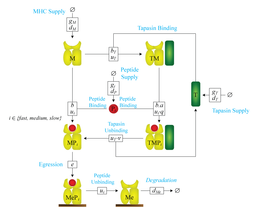Immunotherapy Research: Modelling MHC Class I Complex Assembly
- Homepage
- http://myprojects.cancerresearchuk.org/projects/southampton-research
- Started
- 1st October 2008
- Ended
- 21st December 2012
- Research Team
- Alistair Bailey
- Investigators
- Timothy Elliott, Jorn Werner
The decision as to whether or not a human cell should be killed is made during external surveillance by the immune system.
So how is the immune system able to infer what is happening inside our cells from the outside? How does it know whether a cell is healthy or whether it is infected with a virus or has become cancerous?
The answer is that cytotoxic T-cells from the immune system are able to survey protein fragments at the cell surface that are presented from within the cell by protein complexes called major histocompatibility complex (MHC) class I molecules.
The information they present in the form of peptides indicates the health status of the cell to cytotoxic T-cells. However, there are billions of potential peptides to choose from and the question arises: how does this vast pool get edited down to a population small enough to manage, but specific enough to ensure reliable life or death decision making?
The concept under investigation is that this information, these peptides, are selected for presentation by surprisingly simple mechanisms occurring deep within the cell. Our model produced in collaboration with the Biological Computation group at Microsoft Research uses a principle of peptide filtering to quantify peptide presentation and peptide optimisation in accordance with chemical kinetics and natural selection.
Peptide filtering describes the probability that a peptide, within a cell, will unbind from a complex formed with a MHC class I molecule before it departs for the cell surface. Optimisation describes the relative peptide presentation of a pool of mixed peptides characterised by their unbinding rates.
Evaluation of this model in it's simplest form is performed using a fluorescent polarization in vitro assay system.
Establishing these filtering and optimisation principles are steps towards the ability to predict and quantify system level events: peptide presentation leading to T-cell mediated cell death via a coherent description of the interaction of just a few key components of the larger system.
We are also investigating the structural nature of the MHC Class I complex using molecular dynamic simulations to improve our understanding of system level observations.
Immunotherapy is all about stimulating our natural defences to fight cancer. Although our immune systems are good at recognising peptides from pathogens such as viruses, they are not so efficient at seeing peptides presented by cancer cells - simply because they are our own body cells that are growing uncontrollably.
The ability to quantify and predict peptide presentation through a detailed understanding of the MHC Class I assembly processes would be one step further towards developing new immunotherapy treatments.
Categories
Life sciences simulation: Bioinformatics, Biomedical, Biomolecular simulations, Evolution, Structural biology, Systems biology
Algorithms and computational methods: Molecular Dynamics, Multi-scale, Stochastic Pi Calculus
Simulation software: Gromacs
Visualisation and data handling software: Gnuplot, Xmgrace
Programming languages and libraries: Mathematica, Matlab
